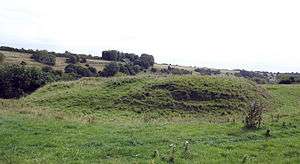Ringwork

A ringwork is a form of fortified defensive structure, usually circular or oval in shape. Ringworks are essentially motte-and-bailey castles minus the motte. Defences were usually earthworks in the form of a ditch and bank surrounding the site.[1]
Ringworks originated in Germany in the 10th century as an early form of medieval castle and at first were little more than a fortified manor house. They appeared in England just prior to the Norman conquest and large numbers were built during the late 11th and early 12th centuries. More elaborate versions (such as Stansted Mountfitchet Castle) comprise a ringwork and bailey, the ringwork replacing the more usual motte and the bailey acting as a military stronghold.[2]
A survey published in 1969 identified 198 ringwork castles in England and Wales, with a further 50 sites that were considered to possibly be ringworks.[3]
See also
| Wikimedia Commons has media related to Ringworks. |
References
- ↑ Friar, Stephen (2003). A Sutton Companion to Castles. Sutton Publishing. p. 246. ISBN 978-0-7509-3994-2.
- ↑ Darvill, Timothy (2008). Oxford Concise Dictionary of Archaeology, 2nd ed., Oxford University Press, Oxford and New York, p. 386. ISBN 978-0-19-953404-3.
- ↑ King, David James Cathcart; Alcock, Leslie (1969). "Ringworks of England and Wales". Château Gaillard: Etudes de castellologie médiévale. 3: 90–127.